Dnieper flotilla - 2023 for NWO
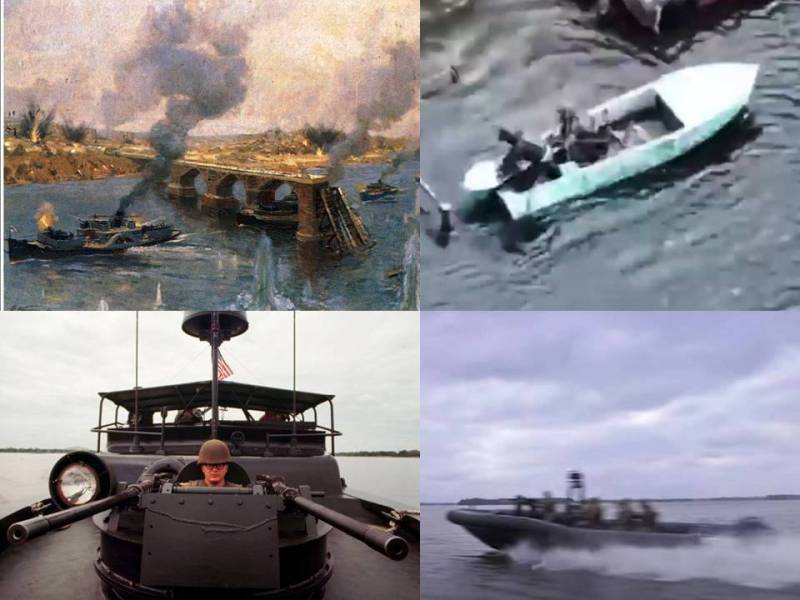
From the report of the Commander of the Black Sea Fleet to Headquarters in the autumn of 1943
(about the battles of boats in the Kerch Strait)
Preamble: taking into account the specifics of the topic and the situation, the article contains an extensive citation (with comments), while everything stated in no way can be considered an exhaustive and complete opinion of the author - enemies will read the public article, and, accordingly, the content ( and default) are given accordingly.
A full disclosure of the topic can only be in the form of a closed document (documents - with different levels of access - on issues of "special topics").
Boats for the Dnieper
From the telegram channel "Notes of midshipman Ptichkin" (with comments):
Michman repeatedly wrote about the critical situation with the provision of our units with watercraft in the Kherson region:
- Publicly - last fall (1), (2).
“Unpublicly, last spring.”
Let me emphasize that the questions were raised by many individuals and organizations. Including "above" (and in front of the High Command of the Navy). "Things and now there."
1. The authorities of the Kherson region this spring began to requisition private watercraft for the needs of the security forces. A good illustration of the effectiveness of providing units with boats, boats, etc.
2. Back in the spring of last year, a number of domestic manufacturers of special boats and boats tried to enter various services with a proposal to supply their products to ensure the safety of the waters of the Kherson region: both the Black Sea and the Dnieper. Some factories were ready to provide the first boats for free. To no avail.
3. Now the issue of providing units with watercraft is not just “acute”. He is critical: this work seems to have failed.
The fact that “blew up” now public opinion was the video of the execution of our soldiers in the old “Kazanka”, who simply could not start the stalled old engine in order to get away from the enemy coast in a timely manner.
1. Boats requisitioned from civilians are suddenly not suitable for special tasks.
2. The need for a “small fleet” only for units that ensure the security of the left bank of the Dnieper is about 100 units.
3. The main need is in boats with a length of 6-8 m. Such a boat should be fast, gliding, protected and be able to be equipped with weapons on a modular basis. Such a boat can cost from 50 to 100 million rubles.
But the appearance of "optimal boats" needs to be clarified. 50-100 million rubles - this is already a rather expensive and “fancy” boat, which, among other things, is a large and “interesting” target and has significant difficulties with camouflage (despite the fact that the cost of just good high-speed interceptor boats measuring 6-8 meters is an order of magnitude less than the indicated amount).
The topic of BEC is closely related to “special topics”, and therefore its discussion can only be extremely limited.
Now there are two key factors to note:
First, we don’t have suitable BECs today, despite the active “development of funds” on this topic. A story about this is objectively necessary, it will be extremely instructive, but it requires literary talents "somewhere between Konetsky and Ilf and Petrov."
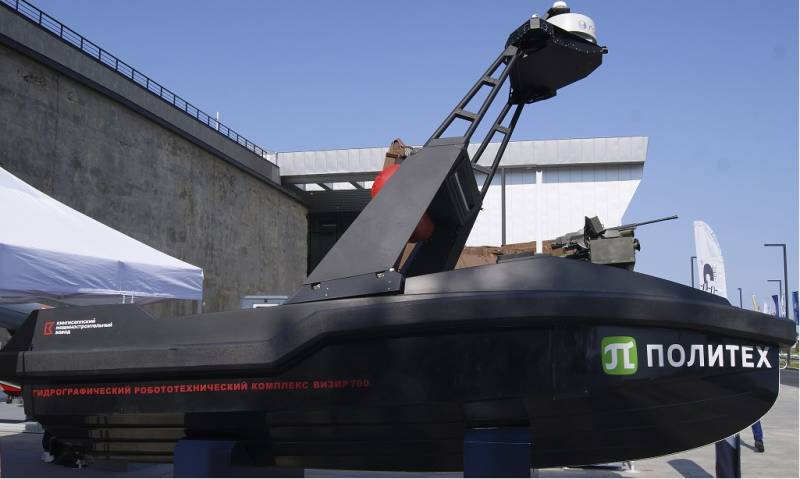
In addition, the latest ongoing work today is extremely “classified” - I take this word in quotation marks, since this is due not so much to regime requirements as (hopefully) to the painful sense of shame of developers (and customers) for how they " fornicated" on this topic earlier.
The second is already for the Dnieper. It is highly advisable to install a remote control kit on those boats that will go there - optionally and if necessary (specific combat situation).
Not certainly in that way. You need to start with the fact that after the breakthrough of the dam of the Kakhovskaya hydroelectric power station, the situation for the actions of boats changed dramatically.
Previously, one of the most promising areas of action (including for boats of large displacement and carrying capacity) was the Kakhovskoye Sea, but now, due to problems with camouflaging boats, their actions there are extremely difficult (and if possible, then only with small boats ).
At the same time, the issue of defending the islands in the Dnieper delta is extremely acute, and without an appropriate group of boats (with the necessary characteristics), a successful solution of this task under the current conditions is unrealistic.
The third direction is the Dnieper-Bug Estuary (and the coastal flank of the front). Quite serious landing operations (tactical landings) are possible and expedient here, including from the side of the enemy (primarily on the Kinburn Spit), and large boats with good landing capabilities are extremely expedient here.
1. Let's imagine a combat mission: ours need to parachute, complete the mission and leave.
2. To do this, you need, say, 6-8 high-speed special boats (the number scales based on the task), as well as several inflatable boats, UAVs and UAVs (integrated into a network-centric system).
3. According to science, landing on 2-4 boats leaves at 2-4 points that have fire links with each other. Another 2-4 boats with a group of fire support ensure the landing. Boats with KKP, RSHO, RPG, etc. maneuver and fire at enemy positions, ensuring the landing.
4. BECs operate nearby, and our birds hang from above, tracking the landing area and accompanying the group.
...It looks beautiful, just like in presentations and cartoons from the Army forum.
The key question to all this is whether other means can perform the same task more efficiently? Let's say a UAV instead of a BEC. It is very important not to get carried away by the “surface of the water”, but to look at all possible options, and “from above” in many cases will be really more effective.
This does not mean that the “waterfowl” should be “abolished”, it means that they should do the combat work that they can really do effectively, and where the capabilities of the same “air” means are limited or absent.
1. In fact, our fighters use ancient Soviet-built boats or unprepared fishing boats with old engines and leaky sides.
2. Well, if the command provides inflatable boats. Sometimes they are bought with their own money or volunteers help.
3. What does the command expect when sending people to tasks on civilian boats? Remember the video of the evacuation from the right bank or from flooded areas? ..
4. Now the Russian security forces are actively updating the “small fleet”: hundreds of watercraft are ordered for billions of rubles. The units that are right now repelling enemy landing attempts in the Kherson region are following these processes with interest.
5. Maybe, first of all, you should think about those who are at the front?
Actually, everything is said.
I would also add about the absolute indifference to what is happening to the leading structures of the Ministry of Defense (the Main Command of the Navy, the Black Sea Fleet, the Engineering Troops, the State Defense Order Department) until the very last moment.
A dangerous adversary who has learned
The question arises, what about the enemy? And now the enemy has a lot of high-speed powerful boats (supplied by the United States), head and shoulders superior not only to the Dnieper "kazanka" (highlighted in red in the inset - a screen from the above-mentioned video of our execution), but also mass working boats and boats of the Navy BL-680.
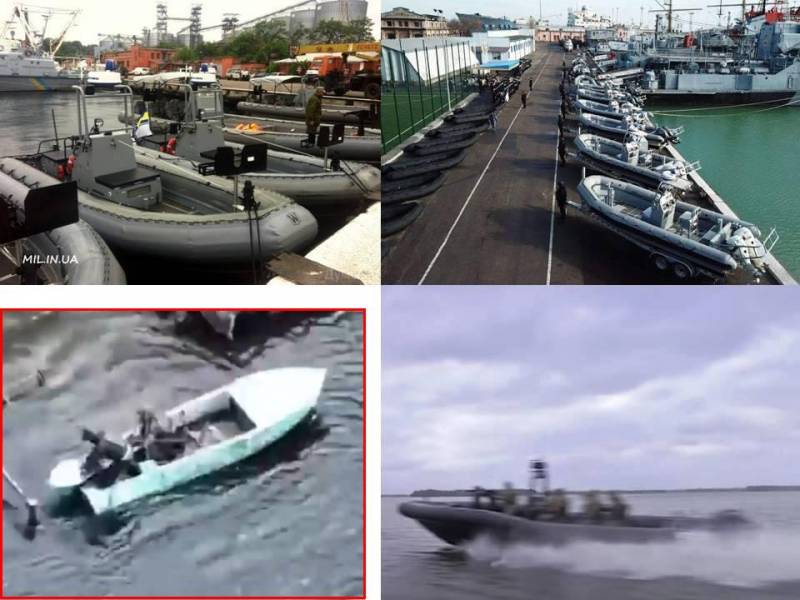
Yes, it all started in the “best Ragulian traditions” - the first delivered boats and boats (which were agreed with the United States under Yanukovych) stood unused for a long time. The situation in 2015, writes a Ukrainian source:
Since then, however, the situation has changed dramatically.
The boats eventually ended up in "prepared hands", plus additional deliveries of a significant number of them, control, training (up to participation in planning their combat use) from the special structures of the United States and NATO. As a result, the enemy received massive, fairly effective combat means, providing even real operational capabilities (for example, for a sudden landing of a fairly large landing as part of a large-scale offensive operation).
The fact that this potential of the enemy has not yet been fully disclosed is only due to the skillful and courageous actions of the fighters and commanders on the ground who directly opposed this (on the same islands of the Dnieper delta). However, the military-technical advantage here is not just for the enemy, in this case it is simply overwhelming and can lead to extremely difficult operational consequences for us.
Dnieper flotilla
It is appropriate to recall stories and the experience of using the Dnieper flotilla and its main historical milestones.
1737 - the birth of the flotilla. Decree of the Senate on the construction of small flotilla ships in the Bryansk Admiralty for operations at the mouth of the Dnieper and ensuring the capture of the Ochakov fortress. The flotilla did not have time to storm and capture Ochakov, the army managed itself, but on October 3, the 40-strong Turkish army, supported by 12 galleys, stormed Ochakov. The vessels of the flotilla played an active role in repelling it.
Russian-Turkish war 1787-1791 - a flotilla was re-formed in the estuary under the command of Rear Admirals John Paul Jones (a legend in American history and the US Navy, now there is a destroyer with his name in the US Navy) and Nassau-Siegen. On June 7, 1788, the Turkish fleet attacked her, but was repelled, and a new attack, undertaken by him on June 17, ended in his defeat.
The events had many vivid episodes, one of which was the feat of lieutenant commander Kh. This case was not just an example of self-sacrifice and the fulfillment of military duty to the very end, but also had significant operational consequences - the Turks began to fear boarding with the Russians.
Potemkin, in a letter to Catherine II dated May 27, 1788, wrote:
At the beginning of the Great Patriotic War, the actions of the Dnieper and Pinsk flotillas created in the 30s were highly appreciated, including enemy documents. First of all, this is the disruption of the enemy’s operational plans to use the Okuninskaya crossing across the Dnieper that he captured (which allowed the Red Army to localize the first Wehrmacht bridgehead on the left bank of the Dnieper).
A bright and heroic episode was the partial breakthrough (two times) of the ships and boats of the Pinsk flotilla through the captured Okuninsky bridge. Ships and boats against enemy self-propelled guns and artillery on direct fire - a desperate heroic battle against an enemy many times superior. A year later, such examples will become widespread already on the Volga, showing both that a tank or self-propelled gun on the shore is simply a deadly enemy of boats, and that even in these conditions the boats managed to carry out combat missions.
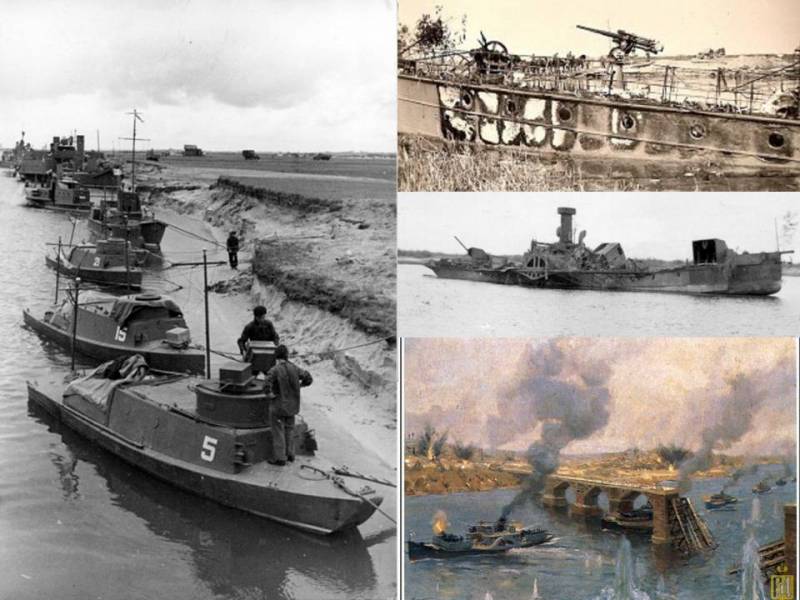
The main lesson for those events today is the need to create boat forces on the river not for parades, but with a clear understanding of the enemy’s real ability to counteract, his reconnaissance and defeat capabilities (which are obviously significantly superior to boats). Success can also be achieved under these conditions, but only with a clear and sober assessment of the enemy's capabilities, his strengths and weaknesses.
NVO: defense of Kherson and the bridgehead on the right bank
The question of the Dnieper and the Liman arose in the very first days of the NMD, with the release of our troops to the near approaches to Nikolaev and obtaining a foothold on the right bank of the Dnieper.
On July 19, 2022, HIMARS guided missile strikes began, first on the Antonovsky bridge, and then on the Kakhovskaya dam and pontoon crossings across the Dnieper, induced by the RF Armed Forces.
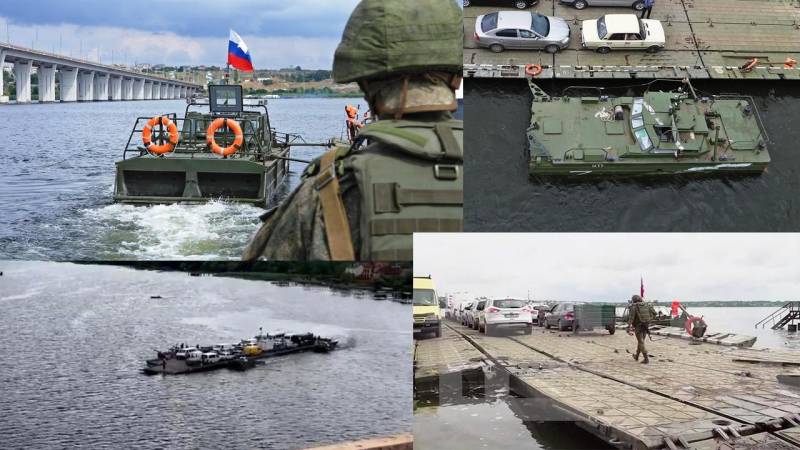
The starting point of the following correspondence was a public post on Telegram:
Author:
The bottom line is that these are mobile objects (i.e., the Highmarses cannot be effectively used on them), capable of approaching the coast in various places and pulling pontoons (near pontoon parks, tugboats have power plants based on these civilian boats).
Those pontoon crossings that are there, the enemy can break at any time (they are stationary).
What is needed is mobile and mass means of crossing.
I know that sensible officers of the Navy raised these questions there back in May, but they were not heard from above. I sound the alarm about this on all channels (I'm not the only one, including people from the bridgehead) - in the "answer" "deaf wall".
Within half an hour I will drop what I sent to the President's reception room (1 sheet briefly), please, if possible, transfer it to Mizintsev.
Answer:
Author:
"Incorrect" surrender of Kherson, to which everything is heading.
Answer:
Author:
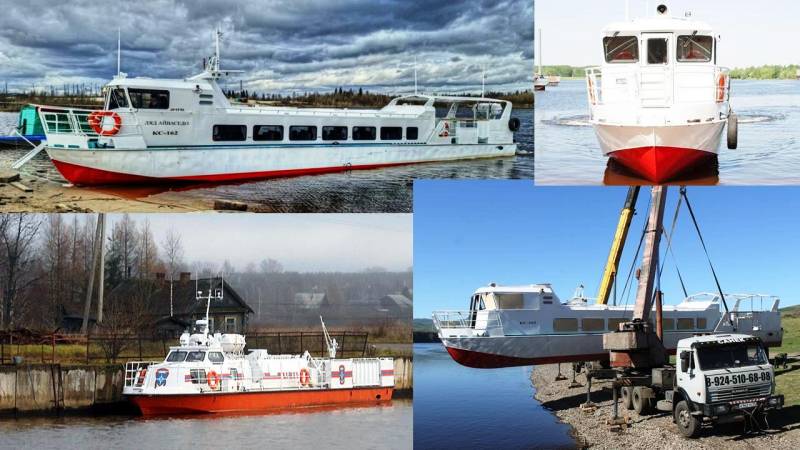
The same Ukrainians mobilized river boats on the Dnieper, and today they have a serious logistical tool there in case we hit their bridges across the Dnieper.
And in terms of the number of these boats (they are not small - about 20 meters long and with a pair of powerful YaMZ diesel engines with good water cannons), the only correct statement of the question is the transfer of EVERYTHING that is possible there (including those located on the Far Eastern rivers and eastern Siberia) - because this is not only reliably provides us with the logistics of the right bank of the Dnieper, but also with proper support (including masking aerosol screens) makes it possible to carry out and provide not only tactical, but also operational landings (for example, on Krivoy Rog), bypassing the Ukrainian defense.
And separately for the much-needed "modern analogues" of the German BDB during the Second World War:
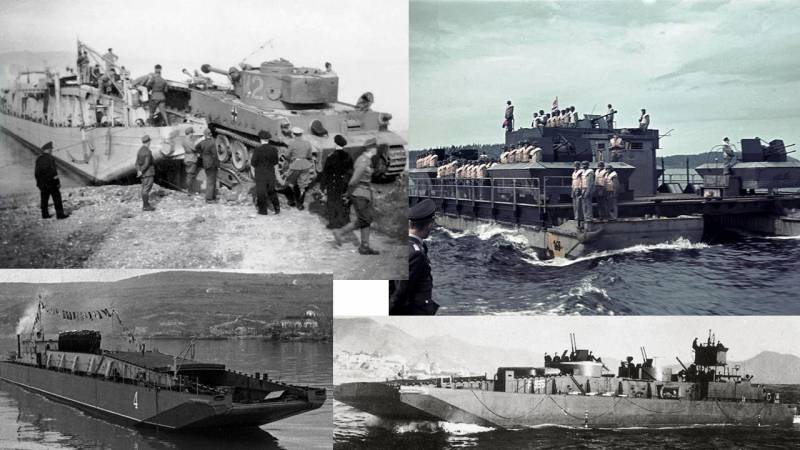
And this, thank God, is there, but we need organizational steps from the Ministry of Defense. Otherwise, a catastrophe on the right bank is inevitable.”
How it all ended is a rhetorical question ...
On the low combat qualities of the main small watercraft of the Navy - BL-680
Both in the Russian Navy and in the US Navy, the main and most common type of RIB is the "7-meter".
In the mid 2000s. a rare case, but in our Central Research Institute of Shipbuilding, a series of serious work was carried out to develop the optimal look and requirements for a new onboard boat (work boat). However, then a very serious mistake was made - the choice of the length of the boat as a "standard" was "slightly less than" 7 meters (6,8 meters).
In the USA, "Villard" "7-meters" ( link), on the contrary, “slightly more” than these 7 m, but this small difference in length gives a fundamentally different level (including combat effectiveness): the payload of the “7-meter boats” of the United States is twice as large, instead of “light” The drive (in our country) is mainly used by the powerful and high-torque Bravo-2, and, accordingly, the speeds with load and in waves are significantly higher than ours.
Figuratively speaking, it turned out to be a “strong light heavyweight fighter” against our “athlete”.
Accordingly, the conditions, quantity and power of the weapons placed on these boats are simply incomparable (not to mention the fact that from the wishes (in the red frame on the sidebar) of the BL-680 military explants on strengthening the protection and armament of the PKF Mnev and K boats, it’s simply declined, and there are simply no such options now).
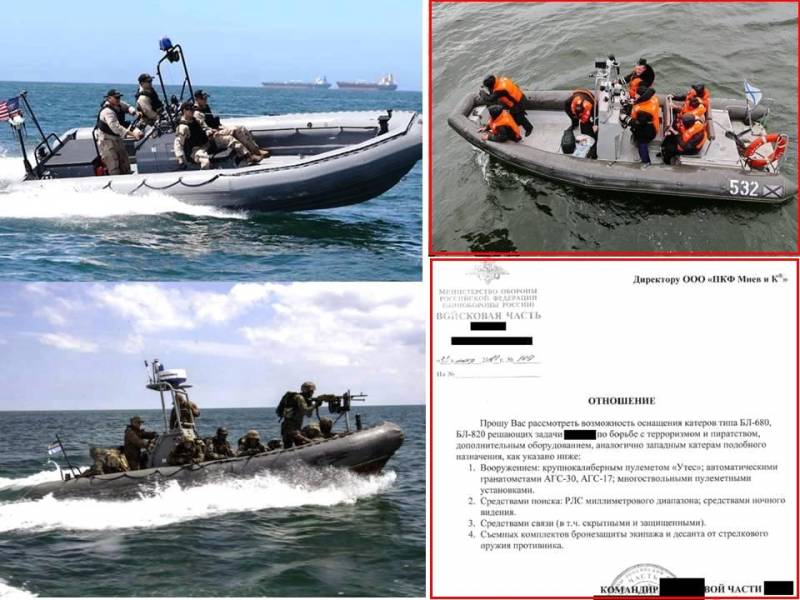
Has this been discussed before? More than, for example, the scandalous article of 2017 "Boat scam" ( link):
The article caused an extremely sharp reaction, but alas, by "sweeping under the plinth" of the existing problems. The author is well aware of how from this "embarrassment" - the mass supply of counterfeit products to the Ministry of Defense and other power structures without RKD at all (because only very "interested" persons can call this term the obscenity that was declared as such) - the Central Research Institute of Shipwreck got out "...
As for the existing BL-680 boats, a clear understanding is needed that it is absolutely inexpedient for these boats to engage in direct clashes with the "villards".
Of course, out of hopelessness, BL-680s can also be used there, but in addition to weak weapons and insufficient speed, the issue of significant trigger weight and (im)possibility of good camouflage will be extremely acute.
RIB RHIB
RIB is a rigid inflatable boat (with a hard bottom and an inflatable balloon), while the function of the balloon is not to create a submerged volume (load-bearing), this is done by a rigid hull, but to increase the height and ensure the “softness” of the side for working in harsh conditions.
Accordingly, to increase the survivability of the soft bead, it is possible (and often advisable) to switch to a slightly heavier foamed (foamed) bead (RIHB).
For military boats, this is especially preferable, and therefore it has become more common lately (however, it leads to an increase in the launch weight of the boat, which is why there is no and will not be a complete transition from an inflatable to a foam board). Also, sometimes even on the RIB, the internal volumes of the hull are foamed - with a slight increase in weight, this gives a sharp improvement in survivability.
The choice of engine type - diesel or gasoline - is determined by the requirements for boats, primarily in terms of speed: gasoline is lighter, other things being equal, more powerful, but more fire hazardous (in addition, the corresponding gasoline is not in the supply of the Armed Forces). Taking into account the latter factor, specialized military boats sometimes use explosion-proof tanks with foam filler (at the cost of some reduction in range) or the free volume of tanks is replaced by an inert gas.
Important - the use of such tanks on civilian boats is extremely rare.
With regard to the material of the hull of boats, the author is a staunch supporter of composite hulls (in addition to purely “shipbuilding”, the factor of camouflage capabilities is also important in this case, but more on that below), but on the condition of their high-quality manufacturing (which requires an appropriate production culture and experienced personnel). A bad (poor-quality) composite case definitely loses to an aluminum one.
Taking into account this factor and the needs in terms of the number of boats, it is impossible to fully provide them with composite boats (it requires a large number of trained personnel, which simply does not exist, and, accordingly, the possibilities for increasing the production of composite hulls are objectively limited), so a significant part of them will inevitably be aluminum.
It is worth noting that in the power structures (and in the navy) there was, let's say, an "ambiguous" opinion about composite boats, but this is primarily due to long-term problems with the quality of the hulls of one of the manufacturers, alas, mass, but having a significant "administrative resource » to impose their products. Under these conditions, posing the question in the form of “only aluminum” was only an attempt to defend against this pressure “from above” (instead of strictly and fundamentally excluding this manufacturer from public procurement altogether).
Here it is interesting to compare boats with a similar purpose and with a close payload - with a composite and aluminum hull. This is especially clearly seen in the example of fairly good aluminum BK-10 and composite SK-860 (their payload is close): a composite boat with the same power has a significantly lower mass and higher speed (over 50 knots versus 40). Both boats are designed to work in difficult conditions; the somewhat smaller SK-860 successfully operates (including in the tasks of a "spoiler" - an interceptor boat) in severe stormy conditions of the winter Barents Sea.
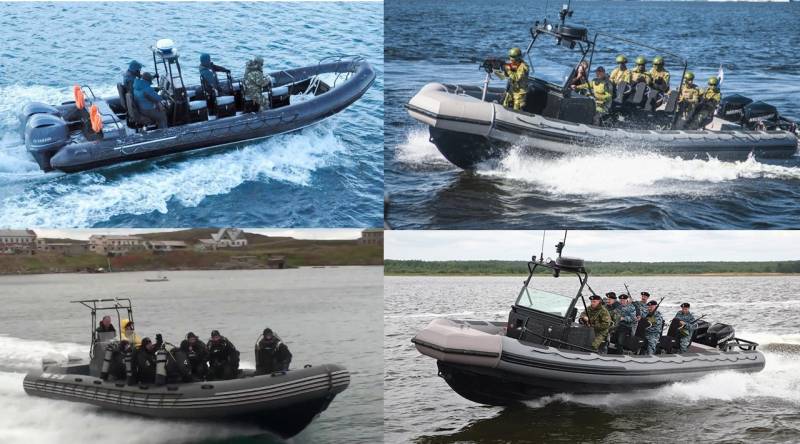
When evaluating the possibilities of using a boat, it is necessary to evaluate them not only by their characteristics, but also by the possibility of using them from the shore, that is, taking into account the possibility of approaching the shore of the “boat-cart (transporter)” system. Accordingly, with a cart (moreover, it provides the possibility of operating on bad roads and lifting the boat in real conditions, and not just from the slipway), the difference for boats that differ in weight will be even greater.
Taking into account this factor (in the real conditions of the Dnieper Delta), the optimal dimension of the mass boat will be significantly less, probably less than 5 meters. This allows, if necessary, to raise the boat to the shore by a group manually (important - this option is not provided for on boats, and it requires a corresponding modification of the hull).
Of course, for boats with an inflatable side going to war, a “reinforced spare parts and accessories kit” is needed, including with additional sets of cylinders.
Specialized river boats
It should be noted that there are special "river" projects of boats abroad. Taking into account much less excitement than in sea conditions, the hulls of such boats have a much larger width (due to less deadrise or even a flat bottom), which significantly improves the conditions for accommodating people and payload on board (with the same weight and speed).
Similar projects were developed by some of our enterprises (for example, "Vineta"), but they are not finished and finished. Nevertheless, such specialized boats are of great value on the Dnieper, and it is highly advisable to urgently create and supply them.
As an example, some Western designs:
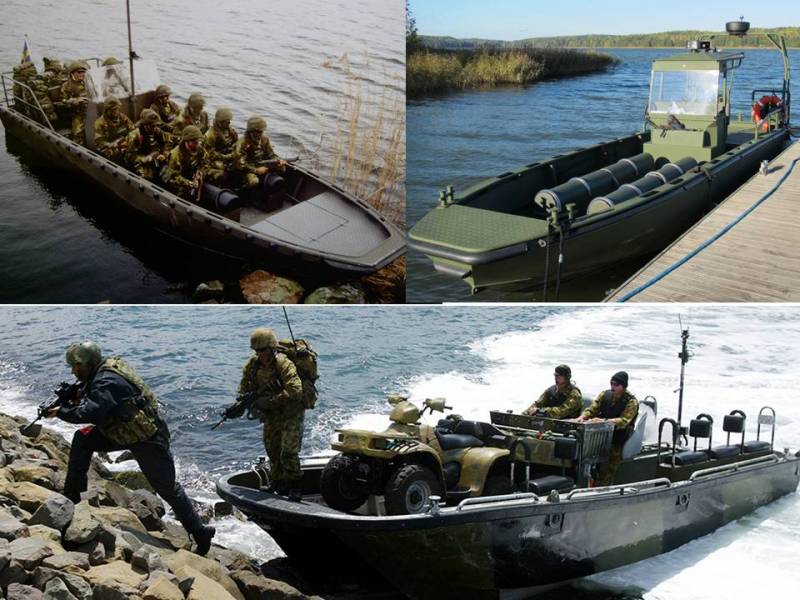
Inflatable boats and light craft
In a number of cases, for the conditions of the Dnieper, just high-speed and high-speed inflatable boats (not RIB) will be enough. The enemy (and their owners) is exactly like this, and "inflatables" (or just small boats and kayaks) are used en masse (and massively). Taking into account the acute issue of camouflage, the solution for us is not the worst (especially given the significant number of domestic manufacturers that make such boats of quite decent quality).
Yes, for such watercraft, the issue of combat survivability is acute, but this issue has a solution - for example, special protective screens for "airbags" (photo in the inset on the top right):
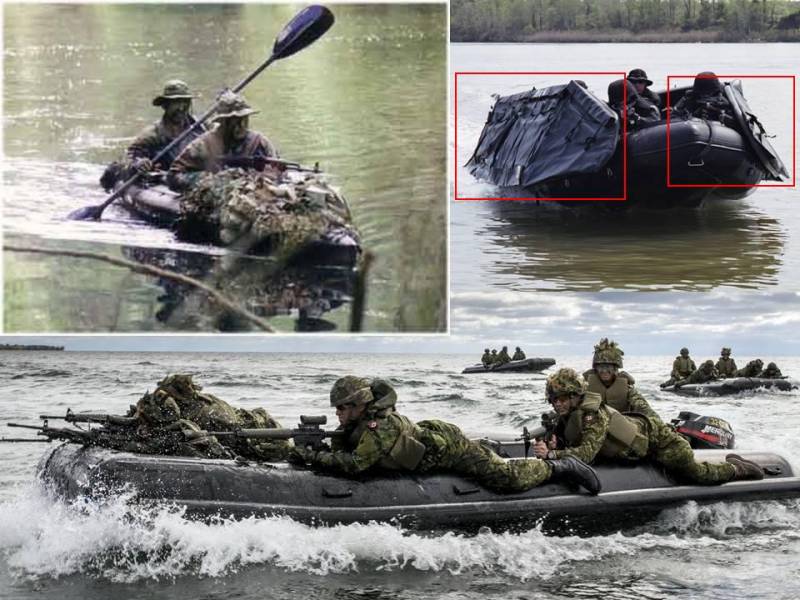
It is also worth noting here that in a number of cases, not a high-speed gasoline outboard motor would be more optimal, but a low-noise electric one.
Are armored boats needed on the Dnieper?
In connection with the repeated proposals for the transfer to the Liman and the Dnieper of the existing armored boats of project 1204 (from the Caspian flotilla that took part in the hostilities in the Sea of Azov), it is necessary to clearly indicate:
• these boats have outdated weapons and means of detection;
• their structural protection is weak;
• the speed is low.
And this is how they were evaluated at the stage of their development - more than half a century ago. Of the available weapons, only the BM-14 MLRS launcher is of some interest, but it can be dismantled and installed on much more popular and useful MTLB transporters at the front.
For the enemy, the Project 1204 armored boat is a large and interesting target.
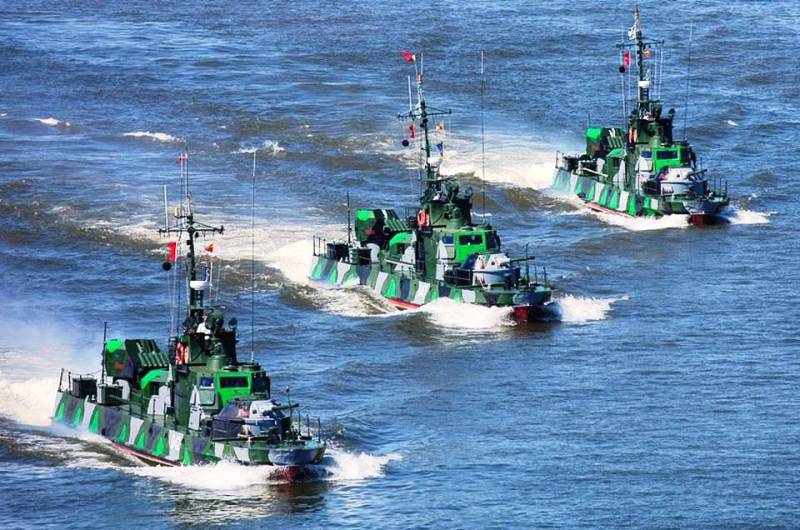
Taking into account the number of enemy tanks, infantry fighting vehicles with automatic guns, ATGMs, shock drones (and just artillery, fragments of which easily sew the thin armor of these boats), reconnaissance capabilities (including constant (regular and at intervals of about 5-6 hours) satellite radar) booking cannot provide protection for boats.

It can only be provided by speed of action and good camouflage capabilities (with the ability to bring the boat ashore).
Sometimes, as an example “for the Dnieper”, they cite the actions of the US Armed Forces on the rivers in Vietnam with the active use of armored boats.
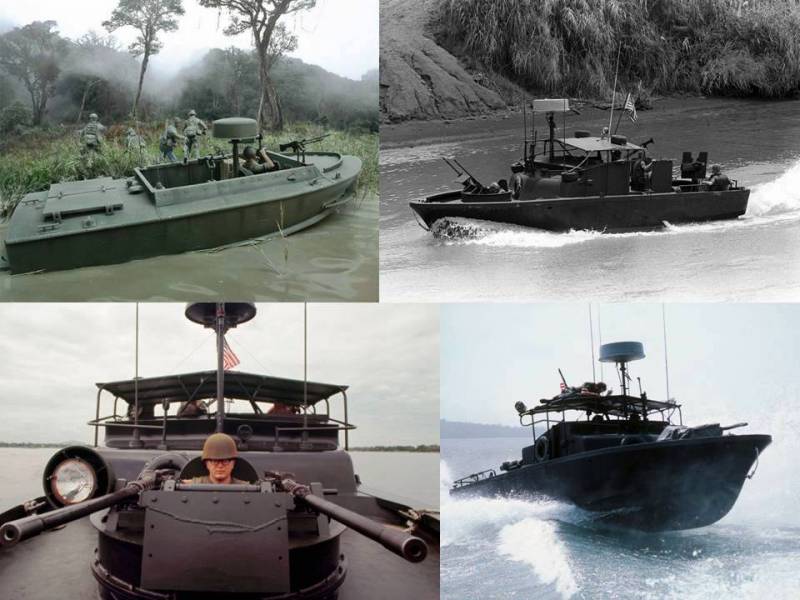
However, it is necessary to understand the conditions under which this was carried out - the complete informational and significant military superiority of the United States. Their opponents had only eyes to detect weapon - AKMs, machine guns and maximum grenade launchers, with very weak means of communication and control. On the Dnieper, the situation is fundamentally different.
Since 2003, American patrol boats have been operating in the Tigris Delta during the invasion of Iraq, and further, since 2007, in the middle reaches of the Tigris and on the Euphrates (until 2011 - more than 6000 patrols), again against an extremely operationally weak enemy capable of only to local injections.
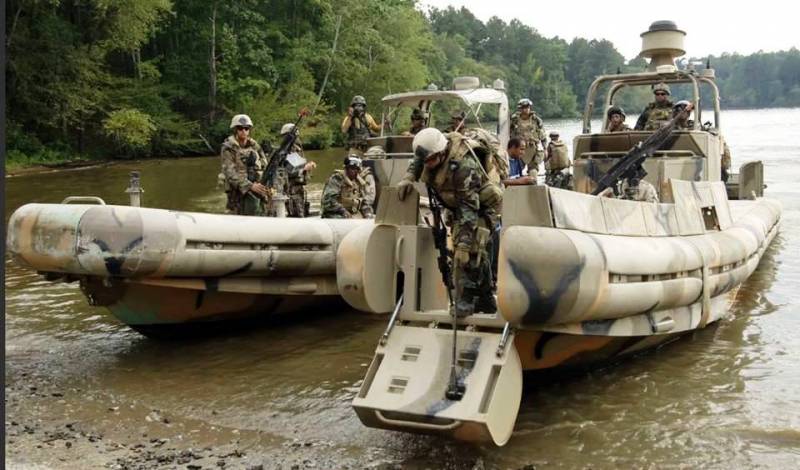
The use of analogues of such boats (and heavier ones, such as the SV-90, Raptor, BK-16) in such conditions, without the possibility of their effective camouflage and cover, will mean the rapid detection and destruction of these valuable combat units.
At the same time, their ability to inflict any serious damage on the enemy is also limited - the actions of sabotage and assault groups in those conditions can only be successful if they rely on surprise (hardly compatible with the insufficient reconnaissance protection of these boats).
The only area where such boats can operate relatively successfully and with tactical sense (without details) is the Dnieper-Bug estuary, where for a long time not only enemy boats, but also an entire medium landing ship (SDK) operated successfully and brazenly, which due to the shortcomings of our intelligence and management, he was able to successfully leave the estuary for Odessa (where, according to the Ministry of Defense, he was sunk almost a year later).
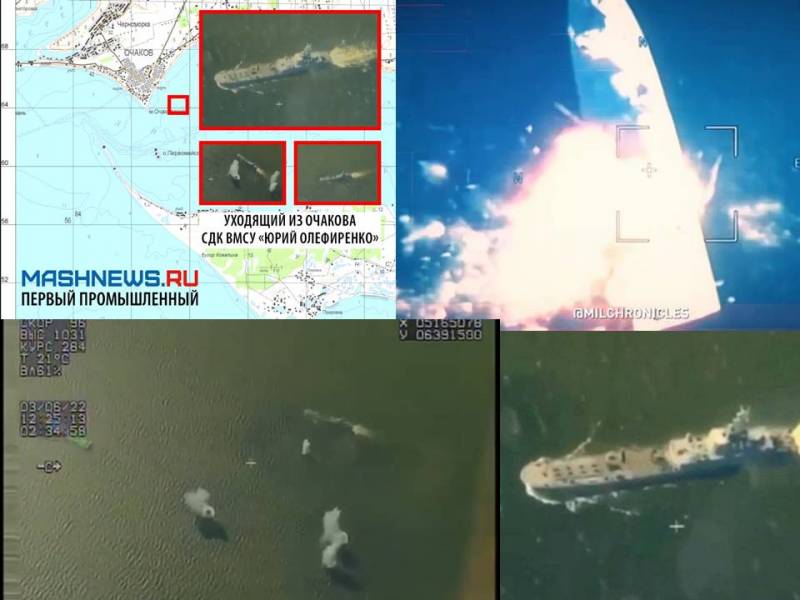
At the same time, it is necessary to understand that the enemy’s capabilities (including the United States and NATO) in terms of intelligence and control there significantly exceed ours.
In this situation, the only type of high-speed armored assault boat that is expedient (according to the principle “it’s not a pity”) to use there is the Trident DSL.
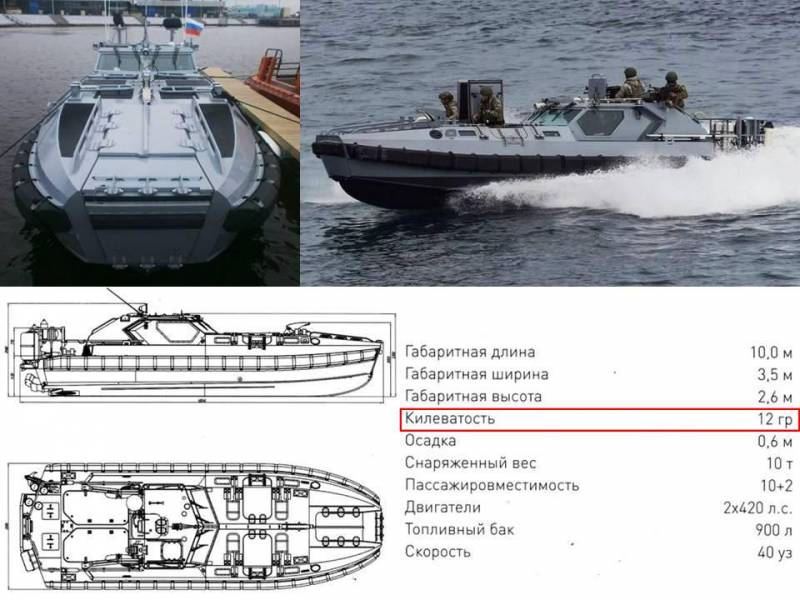
The boat is problematic by the very concept (from the customer - one of the "tops" of the Navy): due to the extremely squeezed dimensions (height - low deadrise), high seaworthiness and speed in developed waves cannot be ensured. The developer here did "101% of the possible", but physics cannot be deceived. For the sea, the DSHL project is extremely doubtful (we will return to this issue in the article on boats), but for the conditions of a closed estuary it may well be suitable (for solving certain special tasks).
About armament of boats
Here it is also necessary to recall the problems of the remote-controlled modules of our boats - the BK-16 did not receive them, and on the Raptors it is a 12,7-mm "Uprava-Kord" with extremely limited ammunition (the developer organization of which ceased to exist ).
We are simply not talking about the extreme need for modules with guided missiles.
The demonstration at the Main Naval Parade in 2022 of the Raptor boat with the Kornet missile launcher nearby (on the Army-2022) turned out to be, in fact, a “mock-up”. We know how to throw dust in the eyes at parades - both to society and to the "first person". “Ceremonial brilliance and combat effectiveness. About the Main Naval Parade and not only "( link).
And even the war and heavy losses (including boats) did not eradicate this habit from us ...
I emphasize that the need to create an effective lightweight remote-controlled stabilized weapon module (DUM) of a weapon (at least 12,7 and a pair of UR) is extremely acute - "yesterday and immediately."
In fact, there are only machine guns with manual control and small arms of the crews. Enemy boats have the technical ability (even without SAMs) to use, among other things, multi-barreled "miniguns" - with many times greater firepower.
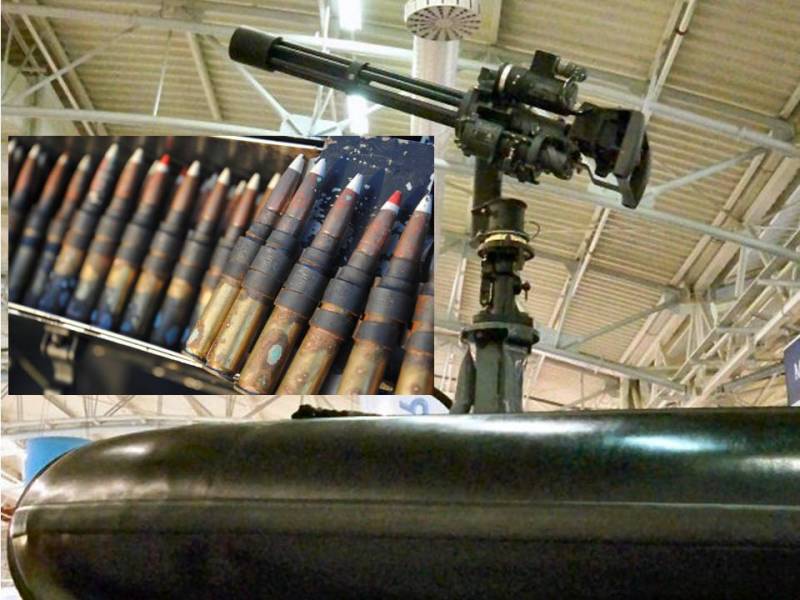
At the same time, the machine gun mounts of American boats obviously do not meet a bunch of our GOST requirements. But they just provide their boats with overwhelming firepower.
Do we have similar machine guns? Yes, there is, but aviation. And it is very incomprehensible which “bells” need to be beaten in order to achieve the completion of existing rapid-fire machine guns for their use from boats and ships (against the same kamikaze boats of the Armed Forces of Ukraine) in the shortest possible time.
I immediately recall the phrase about the battles of boats in the Kerch Strait, from the report of the KomChF to Headquarters in the fall of 1943:
Passive electronic warfare equipment for boats
In the current situation with the means of detecting, controlling and defeating the enemy, passive means of jamming play an extremely important role ... which we do not have (just do not have).
And American boats have, despite powerful means of detection and control and weapons.
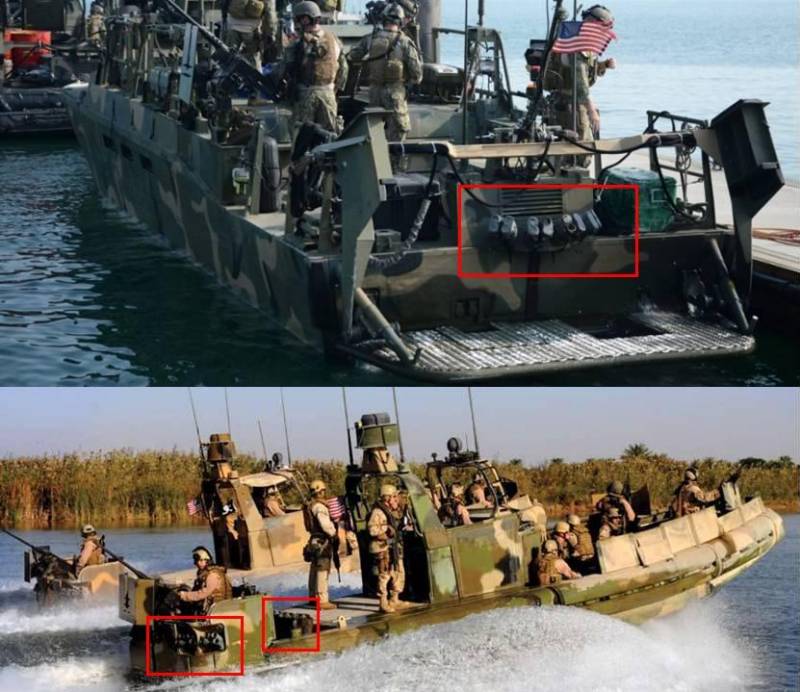
The only one in our country who “sounded the alarm about this” (“long ago and immediately”) was the chief designer of the boats BK-10, BK-16 and BK-18 Pleshivtsev V.V.
Some bosses even heard this - the Novosibirsk IPF began developing a special boat complex for setting passive jamming ... But the speed of these works was such that "when the thunder struck", our boats went into battle with a "bare bottom".
The only thing that now exists on a massive scale is jamming equipment for “large” shipborne passive jamming systems, and given the urgency of the task for boats of sufficient displacement and size, a makeshift launcher is needed for single projectiles of optoelectronic jamming shipborne complexes PK-10 and PK-16 . Well, forcing work on special boat complexes.
In the photo above - the operation of the PK-10 complex on the corvette pr. 20380, below - the German specialized boat complex of passive interference from Rheinmetall:
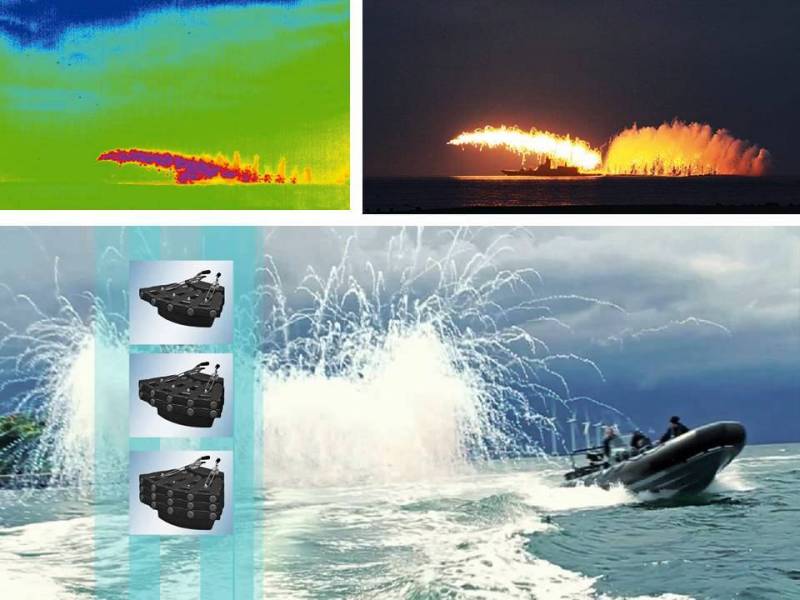
About disguise
Taking into account the enemy's capabilities for reconnaissance and fire damage to boats, the issue of their camouflage on the shore is extremely acute. It should be noted that rather little attention was paid to this issue in the Navy of the USSR and the Russian Federation. Some activities were carried out (the photo in the top left inset is based on nuclear submarines), but their effectiveness and degree of compliance with modern reconnaissance equipment was rather low.
It should be noted the attitude to this issue in some other countries, primarily the Baltic ones: here there are inflatable models of torpedo boats of the GDR, and a whole range of very effective organizational and technical measures in the Swedish Navy to camouflage ships and boats in bases.
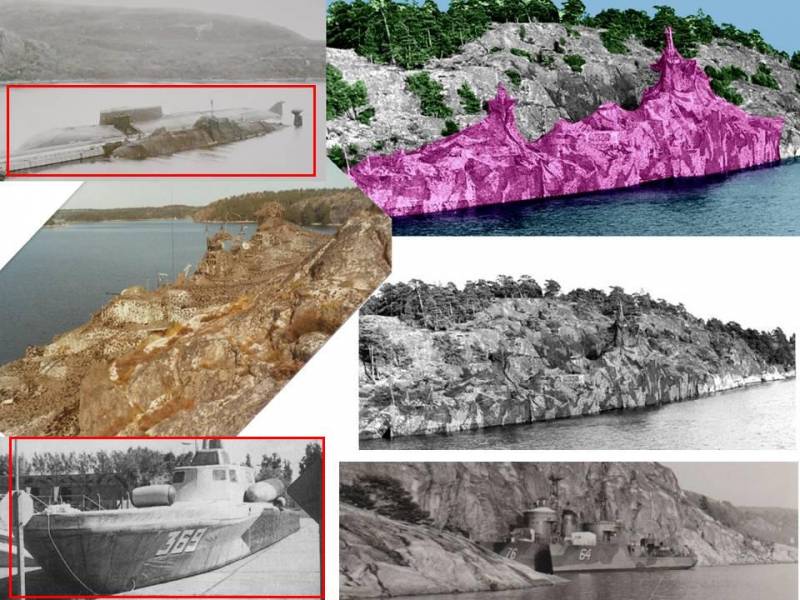
And this foreign experience urgently, immediately needs to be analyzed and applied, including in standard (!) camouflage kits for each (!) Boat delivered to the Dnieper to our troops. What is needed is a “set of coastal support”, and not only camouflage, but also lifting the boat ashore and transporting it (special “carts”, moreover, made taking into account difficult operating conditions on broken and field roads).
In addition, the option of installing removable (or swivel) wheels on the transom seems to be close to ideal, providing the ability to quickly haul a small boat ashore manually, without involving additional forces and means (such as a trailer with a car).
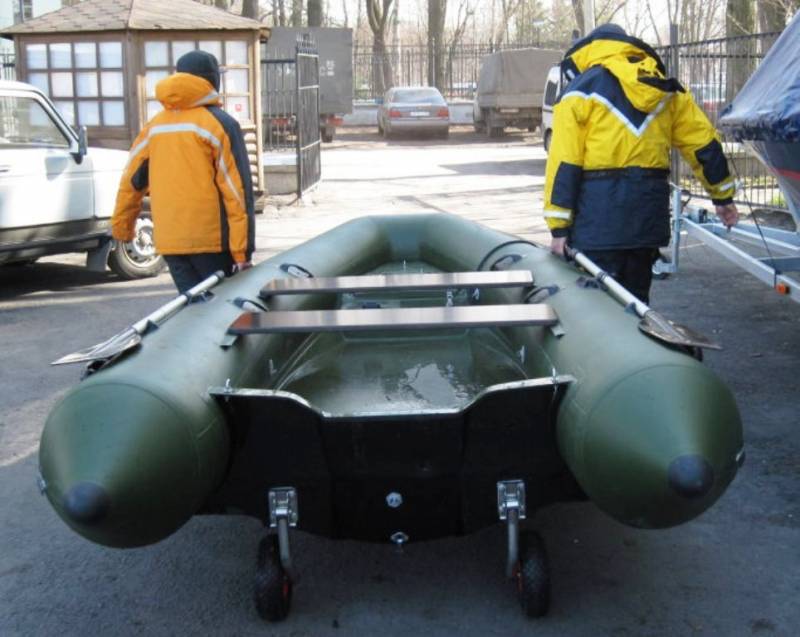
And here, speaking of camouflage (!), it is worth returning to the question of the material of the boat hull - aluminum or composite (and which one).
Aluminum and composite boats have their advantages and disadvantages, however, in the existing conditions on the Dnieper (including taking into account the capabilities of enemy satellite radar reconnaissance), composite fiberglass (i.e., without reinforcements and inclusions from carbon fabric and other similar materials) has significantly less visibility. It also gives a significant gain in survivability.
The use of special radio-absorbing means for masking a metal boat is quite possible and effective - such means exist and are mass-produced, but, unfortunately, they are very expensive.
With all this, you need to understand that it will not be possible to quickly make composite hulls for boats, and aluminum ones are easier to manufacture.
Complete blockage with engineering reconnaissance and mine support
In full accordance with our traditional “everything is fine, beautiful marquise, everything is fine, everything is fine ...” the Ministry of Defense acquired “unique”, “unparalleled” (etc.) engineering reconnaissance hovercraft PRP-4V.
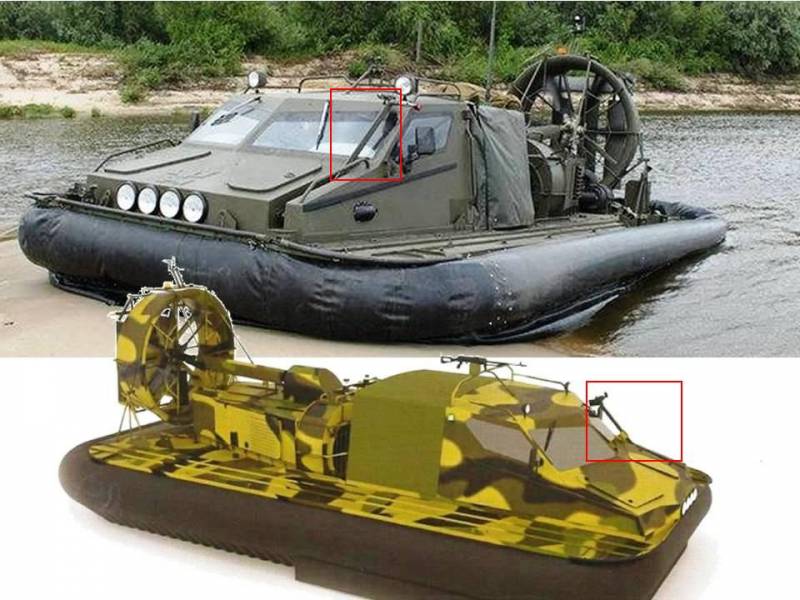
From the website of the Ministry of Defense:
Hovercraft IRK is being developed for the first time. Has no analogues in the world. Previously, an inflatable boat SNL-8 and a set of reconnaissance of water barriers were used to perform the tasks of conducting engineering reconnaissance of water barriers.
The fundamental difference between the boat being developed will be the ability to move the boat on water and land, conduct engineering reconnaissance, both of the water barrier itself and the approaches to it, coastal sections, ice crossings using the built-in modern sonar complex and a set of portable engineering reconnaissance equipment.
The author had to deal directly with this topic, and this very, yet another, “unparalleled” topic. Being invited to a conversation with a “certain organization” (with significant “administrative resources”), initially on the subject of robotic complexes, I received a request from his leadership to help with the “burning” R&D to create this boat (due to the extremely difficult situation for testing and its appearance ). That is, I would like to emphasize that R&D is on the “demolition”, GOSs are on the “nose”, before that all the previous stages of the R&D have been “successfully passed”.
When analyzing the situation and preparing proposals, I started with the simplest and most logical - what, in fact, is required from the IRC by the customer, and how did they solve these problems before?
The result was the author's document "Problematic issues of creating and possible prospects for an engineering reconnaissance boat (and other special search and reconnaissance equipment for shallow depths) for the Ground Forces of the RF Armed Forces and the Russian Navy."
Due to the fact that I received a warning in time that “you will not be paid”, the most “tasty part” was “torn out” from the document - according to the classification of targets (then the company “danced on a rake” everywhere, starting from the Nakhabin training ground of the Engineering Troops ) and handed over the document. I never received money for the work, the topic is open, so I am free to quote.
To begin with, it should be noted that in the USSR Armed Forces these tasks, methods for their implementation and technical means for this were well thought out (at that level of technology, of course) - both in composition and in technical characteristics (for example, operating frequencies of search tools). In general, it is worth noting especially, having, as a rule, limited capabilities for digital information processing, the old Soviet technology had very high-quality and well-thought-out system engineering and a competent, reasonable choice of the main operating parameters (which, alas, is largely lost today).
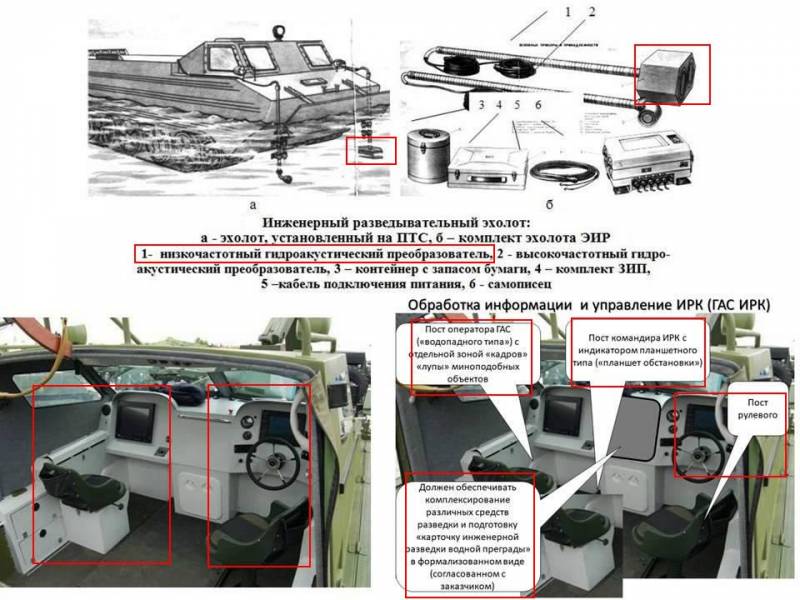
Above is a Soviet complex for reconnaissance of water barriers placed on a floating conveyor (including with a low-frequency (!) Echo sounder), at the bottom left - “what happened” in the ROC at an “organization with a significant lobbying resource”, and on the right - the author’s suggestions, how still make them perform at least part of the tasks of this IRC.
From the document:
• the issues of the operator's work on the reliable search and classification of small-sized objects in solving special tasks of the Navy and the Defense Ministry have not been worked out, the size of the indicators is insufficient;
• the presence of only one regular HBO indicator excludes the solution of special tasks;
• … processing of information with reference to its coordinates… does not meet the requirements of the RF Ministry of Defense…
This list of shortcomings of the IRC practically excludes them the possibility of effectively solving special tasks for their intended purpose.
Let me remind you that before that, the previous stages of R&D were “successfully passed” (and accepted by the customer from the Engineering Troops), including the defense of the technical project and preliminary tests).
• notorious insecurity from explosions on mines with proximity fuses;
• extremely low search efficiency for mines due to the presence of a small-sized indicator in a single operator, which does not provide a combination of the “waterfall” and “tablet” modes;
• lack of means of destroying the discovered mines.
... it is necessary to have close interaction between the helmsman of the CFM and the HBO operator, the main thing is that the helmsman of the CFM must clearly see that ... it is moving along the already surveyed area ... there is an obvious need for the HBO to include not only the traditional “waterfall type” indicator with an “instant picture” of the HBO review (with subsequent the creation of a "tablet"), but also a panoramic ("commander's device") with the provision of the issuance of search tacks and a general "search picture" ("surveyed area") to the helmsman's console.
To ensure the survey of detected mine-like objects, it is advisable to include in the specification of the RMC a small-sized inflatable boat and low-magnetic diving equipment ... as well as ... and other means that ensure the fulfillment of the tasks of the RMC for its intended purpose (for example, a manual penetrator).
That is, this "engineering reconnaissance" boat (in quotation marks) did not even have a penetrator!
As mentioned in paragraph 1, the task of engineering reconnaissance of water barriers is much broader than the particular task of searching and surveying SSS, it is necessary to automatically integrate all reconnaissance data into a general report (a promising and agreed with the customer "Engineering Intelligence Card", suitable for transmission according to ESU TK). »
The result of all this ... Konashenkov Department, 11.10.2020/XNUMX/XNUMX:
That is, nothing was fixed, and The IRK was adopted by the Ministry of Defense (Engineering Troops), in fact, being unable to solve tasks as intended.
And very tough and difficult questions arise - who, with what and how carried out engineering reconnaissance of water barriers, for example, right there:

And who and how is going to carry it out in the "Red Army" (and whether to carry it out at all)?
I emphasize once again - IRK PRP-4V, in principle, is unable to conduct it, not only at the modern level - even at the level of the old requirements of the USSR Armed Forces!
And here is another very difficult question - and who, how and with what is going to deal with mines? Including with bottom non-contact?! And taking into account the fact that, looking at the "lethargic dream" on this issue of the "valiant Navy", the enemy has already begun laying such mines!
Or do the Navy and the Ministry of Defense intend to continue to solve the problem with such “Mariupol creatives”?

But there the level of enemy mining was simply “illiterate-cave”, and work to eliminate the mine danger was carried out in the absence of any opposition!
If at relatively significant depths the Russian Navy has, although extremely limited, but at least some capabilities, then in the zone of shallow depths it is practically “zero”, only cord charges (with an extremely small destruction band, and most importantly, it is not clear where the mines are, on which put them).
At the same time, just before the NWO, the last anti-mine boats are decommissioned - RTCH for shallow depths (without any replacement).
At the same time, we are destroying the only ARZ (in Sevastopol), which carried out and is able to carry out repairs of Mi-14 helicopters (the anti-mine modifications of which were in the USSR Navy, including those designed to work at shallow depths).
At the same time, the only sample of the search complex suitable for high-performance search for mines, including at shallow depths and including from a helicopter (the capabilities of which were obtained on an initiative basis at the cost of great effort and nerves), although it is purchased by the Ministry of Defense, but still has not been tested for operation in these conditions.
Let me remind you that more than 500 days have passed since the beginning of the NMD (and the disruption of the landing operation of the Black Sea Fleet due to the extremely illiterate, but successful mine laying of the Ukrainian Navy).
Oh yes, the “spitz” has a parade “on the nose”! And the CBO will once again “wait”!
The Navy mutters “mantras” about the “promising project 12700”, despite the fact that the events of the NWO not only confirmed, but also extremely harshly posed problematic questions on it, formulated earlier in the “VO” (What's wrong with the "newest" PMK project 12700?) and in NVO (Russian Navy ran into mines and submarines).
- the outdated concept of an MIP is a ship “before the first modern mine”;
- knowingly unsecured actual explosion resistance;
- inability to solve multipurpose tasks (at least at the level of the 266М project);
- limited effectiveness at shallow depths. "
To some bosses it seems “logical” throw on mines PDRK type "Rook" (having hydroacoustics "Kalmar" based on a multi-beam echo sounder and ROV "Marlin-350"). Calling things by their proper names, it will be a "meat assault" "in the sea", with sending boats and people just to slaughter.
And the question of this was raised even before the CBO: About "Rooks", "Marlins" and old minesweepers.
Note: in fact, the situation is not as fatal as it seems. There is a serious groundwork for “what is needed” made by a number of organizations in previous years, there are serial complexes that no one bothered to not only deliver for mine action, but stupidly even carry out the necessary tests, but they are ...
But the main problem is not equipment, not weak (or simply absent) training of personnel, but no “organization” today, or rather, disorganization of command and responsibility.
In fact, today we have a complete "ignorance" of real critical problems - both previously known and opened by the NWO, primarily by the high command of the Navy. Moreover, all this is quite competently covered up by “departmental disunity” and sometimes “cutting areas of responsibility” at the level of mere cretinism.
Mine fighting? The Navy "mriit" "missile submarine battleships" and "ocean depths"! For in the documents (for the “especially vigilant” - there are both public, public, and official links to this) this is the area of responsibility of the Engineering Troops (on the rivers) and the Logistics of the RF Armed Forces (represented by the Marine Engineering Service), where there is nothing at all for this ( and from the word "absolutely")!
And I wonder if the Chief of Logistics of the Armed Forces of the Russian Federation himself is generally aware of this situation?
So who still has to and is going to fight mines? Volunteers again? And they will do it! Only now it would be more correct to collect money for this not from “grandmothers”, but to take from the allowance of responsible bosses who completely failed the case (and left both the Navy and the RF Armed Forces without any effective mine defense).
It “reached” (“reached out”) to the “tops”, “the process went on” ... but where?
First:
With the money received, we will purchase more than 150 boats. This requires about 70 rubles. We can do it with you.
Let's do it together! To give the guys an extra chance to survive! To never again watch helplessly the cold-blooded murder of our sons, fathers, husbands ... "
Actually, the essence of this message is that the issue was perceived and taken under control already at the level of the Presidential Administration. With all the consequences.
Second, from the telegram channel "Notes of midshipman Ptichkin":
And even earlier, manufacturers received a number of orders for the "small fleet". Some of them have already been completed.
Let's hope the new boats will show themselves well.
The issue of the development, production and use of unmanned boats in the NVO zone remains extremely relevant.
The midshipman thanks the friendly channels for their attention to the problem: Igor Ivanovich Strelkov, Ghost of Novorossiya, Two Majors, ROKOT, Rybar, Alexei Zhivov and many others.
Problem solved? No!
For now we will get a situation with mass deliveries of Maviks at the beginning of the NWO - when they simply “driven to the front” equipment (and sometimes without really thinking about what), without training (tactics!), Additional batteries, means of display, transmission and data processing.
This gave a certain positive effect, but the efficiency of these efforts and the resources used was “like that of a steam locomotive”. Now we will get the same thing (let me remind you of only one “pitfall” of operation, and what is the almost complete absence of the corresponding fuels and lubricants in the Ministry of Defense).
Now the organizational component is critically important.
At the "top" the problem is heard. And at the very top. But its solution can only be complex - organizational-technical.
It is necessary to raise the issue and with a sharp public reaction through the Presidential Administration to "squeeze" the decision and the issues of the issue - the creation of both a military structure responsible for the region of the Dnieper, Liman (and not only), and a public one, providing effective assistance and support.
An extremely important issue is the leadership and subordination of this organization. At the same time, the color of his uniform does not matter, only the mind, determination and readiness for the sake of the Cause to shake the "spitz" of the so-called. "almshouses".
Let me remind you that our fleet carried out its most outstanding victory (Chesma) under the command of General A. G. Orlov.
Accordingly, there can be no question of any subordination to its fleet (or even more so to the Spitz) - only to the High Command of the united group!
From the book by Vladimir Semenov "The Fleet and the Maritime Department before and after Tsushima":
“Do you know which dog breed is the nastiest?” the Admiral suddenly asked.
(Question mark on the faces of the interlocutors).
- Spitz!
Not everyone immediately understood, but when they understood, they laughed; however, one of those present, the old captain ... found something to "overthrow" the admiral.
- Not one dog, but two ... And they live in great friendship ...
– What else?
- Dachshund ... and, contrary to the laws of nature, quite high ...
Then everyone immediately understood and ... "they laughed a lot at this."
Yes, a significant part of the boats that were discussed will simply go to the ground units and the Barca, but even on issues of operation, rearmament, etc., a single control body is needed. Again - identification on the river ... Not to mention the conduct of individual (and even more so special) operations.
Taking into account the real situation, the “operational headquarters” “Dnepr and Estuary” seems to be optimal, to which a special “Bars” for river operations is directly subordinate, and which interacts with army units on the shore (received boats and other watercraft), having with them an “administrative department » comprehensive support for the operation of boats for all structures.
Conclusions
1. At present, an extremely threatening operational situation has developed on the Dnieper (and the Dnieper-Bug estuary), taking into account the absolute military-technical superiority of the enemy in terms of boat boats.
2. It is necessary to urgently take measures to equip the units of the RF Armed Forces in this direction with the necessary number of boats and watercraft with the appropriate characteristics.
3. Ensuring this today is possible primarily due to civilian samples, which must receive the necessary refinement (including in terms of a set of camouflage and additional protection) to solve special problems.
4. The same is required for special boats, but created for other tasks and a different level of counteraction.
5. It is necessary to accelerate the creation of special means - landing and landing boats, special boats (including unmanned ones), means of engineering reconnaissance and combating mine danger.
6. One state is not able to quickly solve these tasks (for "legal reasons"), significant, thoughtful and coordinated assistance from volunteer organizations and special funds is needed.
7. The main thing is that for operations on the Dnieper and Liman, an operational body of military command and control is needed with administrative structures that provide refinement and operational support to the boats.
I emphasize that all this is taking into account the open publication of the article. The detailed proposals of the author (including those previously proposed) - both in terms of technology and in solving problems by purpose - can only be discussed in private.
Information